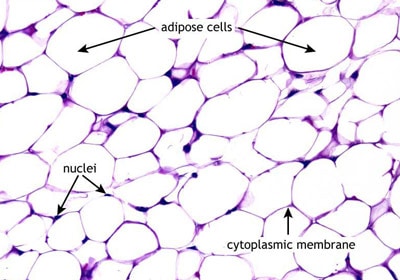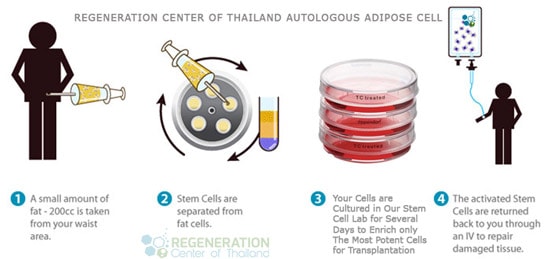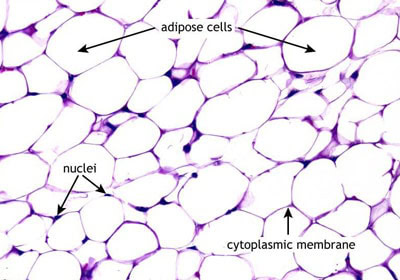Adipose tissue pertains to fat, which is primarily made up of fat cells known as adipocytes. [1]
Adipose stem cells or “ASCs” are an source of therapeutic mesenchymal cells for younger patients or those seeking cosmetic treatments like stem cell breast treatment and stem cell facelifts. Unlike the limited quantities of bone marrow derived stem stem cells “BMSCs” The adipose tissue or “Fat Stem Cells” can be extracted in fairly large quantities using special mini-liposuction aspiration before they are expanded in a special stem cell lab for several days in vitro.[2] Adipose fat stem cells and Preadipocytes are useful in treatments since they have the ability to home and undergo osteogenic, adipogenic, chondrogenic, and even neurogenic differentiation using our proprietary growth medium. Adipose stem cells are also immunoprivileged and have virtually zero chance of rejection thus preventing any risk of getting graft-versus-host disease. [3]
Despite the promising results, however, fat stem cells and lipofilling can provide unpredictable graft retention rates unless enriched/cultured for several days. Without proper cell culturing the reabsorption rates can be very high varying from 40% to 85% [4]

Adipose Fat Cells Under Microscope
Adipose tissue can be found in pockets of fat near the lower abdomen and inner thigh regions only. The tissue is believed to have adult stem cells; thus, its common use in cosmetic stem cell therapies. The extraction and isolation of adipose “fat” stem cells are usually performed through a closed-system mini-liposuction and the expansion with cell culturing medium requires several days before they can be reintroduced to the patient for variety of treatments including peripheral neuropathy, heart attacks, strokes and Coronary artery disease (CAD).

Characteristics of ADSCs:
- Multipotency: Like other MSCs, ADSCs can differentiate into various cell types, including adipocytes (fat cells), osteocytes (bone cells), chondrocytes (cartilage cells), and myocytes (muscle cells), among others.
- Abundance: Adipose tissue is abundant in the human body, making it a readily available source of stem cells.
- Ease of Harvesting: ADSCs can be obtained through liposuction, a relatively simple and minimally invasive procedure.
- Immunomodulatory Properties: ADSCs can modulate immune responses, making them attractive for therapies related to immune-mediated diseases.
Potential Applications of Adipose Stem Cell Therapies
- Regenerative Medicine: Given their ability to differentiate into various cell types, ADSCs are being explored for tissue repair and regeneration.
- Cosmetic and Plastic Surgery: ADSCs are being investigated for their potential in skin rejuvenation, wound healing, and scar reduction.
- Treatment of Degenerative Diseases: Their immunomodulatory properties make ADSCs candidates for treating diseases like osteoarthritis.
- Cardiovascular Diseases: ADSCs have shown promise in promoting the repair of damaged heart tissue after myocardial infarction (heart attack).
- Neurological Diseases: Preliminary studies suggest that ADSCs might offer therapeutic benefits for conditions like Alzheimer’s disease, Parkinson’s disease, and spinal cord injuries.
To learn more about our Enriched Adipose tissue derived stem therapies please contact us today.
Published Clinical Citations
[1] ^ Harasymiak-Krzyżanowska, Izabela, Alicja Niedojadło, Jolanta Karwat, Lidia Kotuła, Paulina Gil-Kulik, Magdalena Sawiuk, and Janusz Kocki. 2013. Adipose tissue-derived stem cells show considerable promise for regenerative medicine applications. Cellular & molecular biology letters, no. 4 (August 14). doi:10.2478/s11658-013-0101-4. https://www.ncbi.nlm.nih.gov/pubmed/23949841
[2] ^ Mohammadi, Zahra, Jalil Tavakkol Afshari, Mohammad Reza Keramati, Daryoush Hamidi Alamdari, Meysam Ganjibakhsh, Azam Moradi Zarmehri, Ali Jangjoo, Mohammad Hadi Sadeghian, Masoumeh Arab Ameri, and Leila Moinzadeh. 2015. Differentiation of adipocytes and osteocytes from human adipose and placental mesenchymal stem cells. Iranian journal of basic medical sciences, no. 3. https://www.ncbi.nlm.nih.gov/pubmed/25945239
[3] ^ Salyutin, R V, K M Zapohlska, S S Palyanytsya, V M Sirman, and M F Sokolov. 2015. [Differentiation of mesenchymal stem cells of adipose tissue]. Klinichna khirurhiia, no. 3. https://www.ncbi.nlm.nih.gov/pubmed/26072548
[4] ^ Zanetti, Andrea S, Gregory T McCandless, Julia Y Chan, Jeffrey M Gimble, and Daniel J Hayes. 2013. In vitro human adipose-derived stromal/stem cells osteogenesis in akermanite:poly-ε-caprolactone scaffolds. Journal of biomaterials applications, no. 7 (June 24). doi:10.1177/0885328213490974. https://www.ncbi.nlm.nih.gov/pubmed/23796629

